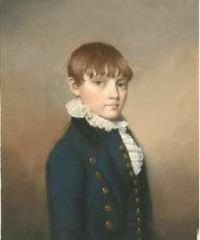In Paris, Tom dined every Saturday with the American minister, James Monroe and his wife Elizabeth ("one of the finest women I ever knew"). the Monroes introduced Tom to Adrienne Lafayette, the wife of the Marquis who was then being held in prison in Austri
 a. With the political situation in France terribly unstable, Madame Lafayette wanted desperately to get her thirteen-year-old son George Washington Lafayette out of the country and to the United States where she hoped that the boy’s godfather, President Washington, would take care of the boy.
a. With the political situation in France terribly unstable, Madame Lafayette wanted desperately to get her thirteen-year-old son George Washington Lafayette out of the country and to the United States where she hoped that the boy’s godfather, President Washington, would take care of the boy.In April of 1794, Tom secured the necessary travel documents and conveyed the boy, who was travelling under the family name of Motier, to Le Havre, where he took passage on board one of the firm’s boats bound for Boston. James and his family warmly took young Lafayette under their wing as part of their family in Boston when he arrived. Washington hesitated to send for the boy, nervous that it might affect diplomacy with France, but finally “his heart overcame his doubts” and he sent for the boy in the spring of 1796 to live with him at Mount Vernon.
Tom still had time to kill while he was in Paris. After the fall of Robespierre, the prosecuting attorney Fouquier Tinville, along with the judges and jurymen which had condemned so many of the innocent and helpless, was to be executed in the Place de Greve. With his friends Russell and Higginson, Tom hired a window in a house on the square to witness the executions. The prisoners arrived in two carts; they were taken out, and placed in the room directly under the scaffold. From there they were taken, one by one, and, by a ladder of eight or ten feet, were brought to the guillotine, and decapitated. They all met their fate without a struggle except for one of the judges who vociferously cursed his executioner until silenced by the fall of the blade.
 "From the time the prisoners descended from the carts, until their heads were all in long baskets, placed in the same carts with the lifeless trunks, was fourteen minutes. Two minutes were lost by changing the carts; so that, if all the remains could have been placed in one basket, but twelve minutes would have been required for beheading the sixteen persons! The square was filled with people. Great numbers of the lowest classes — and the low class of women were the most vociferous — were there, clapping and huzzaing with every head that fell. These were the same people who sang hallelujahs on the deaths of those who had been condemned to the guillotine by the very tribunal who had now paid the debt they owed to the city; for their convictions were principally of the city. Other wretches of the same stamp were acting their infernal parts in different departments of France. Notwithstanding the deserts of this most execrable court, the exhibition was horrid to my feelings, however deserved the fate of the culprits."
"From the time the prisoners descended from the carts, until their heads were all in long baskets, placed in the same carts with the lifeless trunks, was fourteen minutes. Two minutes were lost by changing the carts; so that, if all the remains could have been placed in one basket, but twelve minutes would have been required for beheading the sixteen persons! The square was filled with people. Great numbers of the lowest classes — and the low class of women were the most vociferous — were there, clapping and huzzaing with every head that fell. These were the same people who sang hallelujahs on the deaths of those who had been condemned to the guillotine by the very tribunal who had now paid the debt they owed to the city; for their convictions were principally of the city. Other wretches of the same stamp were acting their infernal parts in different departments of France. Notwithstanding the deserts of this most execrable court, the exhibition was horrid to my feelings, however deserved the fate of the culprits."Tom returned to the states. In 1796 he met up with Washington in Philadelphia. The president thanked him profusely for all his help arranging for young Lafayette's passage, and invited him to visit him in Virginia.
Tom spent a night with the president in Mount Vernon. Sitting outside and talking, a toad hopped by. Washington asked Tom if he had ever seen a toad swallow a firefly. Well, he had, said the president, and through the thin skin of the toad had been able to see the light continue blinking after it had been swallowed.
No comments:
Post a Comment